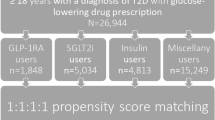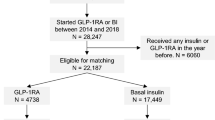Abstract
Aims
Several GLP-1 receptor agonists (GLP-1RA) have become available for the treatment of type 2 diabetes (T2D), and evidence on their beneficial effects has evolved. We evaluated how the clinical phenotype of patients initiating GLP-1RA changed from 2010 to 2018.
Methods
This was a retrospective study conducted at six diabetes outpatient clinics in Northeast Italy. We collected data of T2D patients who initiated new GLP-1RA between 2010 and 2018. We recorded baseline characteristics, including demographics, anthropometrics, cardiovascular risk factors, glucose control, lipid profile, liver enzymes, renal function and concomitant medications. We recorded updated HbA1c and body weight at follow-up.
Results
There were 83,116 T2D patients from a general population of ~ 1,380,000 inhabitants. Among 6167 cases of GLP-1RA initiation, 5408 were analyzed after excluding intra-class switchers. Prescription of GLP-1RA increased exponentially, and the change in the type of GLP-1RA reflected waves of their entering the market. From 2010 to 2018, there were significant increases in baseline age, diabetes duration and prevalence of male sex, of cardiovascular disease and of insulin users. Blood pressure and cholesterol levels decreased concomitantly with increasing use of medications for the control of cardiovascular risk. Baseline average HbA1c (8.3% [67 mmol/mol]) and BMI (34 kg/m2) and their improvement after GLP-1RA initiation did not change over time.
Conclusions
Despite the early positioning of GLP-1RA in T2D treatment algorithms, GLP-1RA have been prescribed in patients with progressively more advanced disease stage and especially in the presence of cardiovascular disease. Optimization of GLP-1RA use in routine clinical practice is still needed.




Similar content being viewed by others

References
Drucker DJ (2016) The Cardiovascular Biology of Glucagon-like Peptide-1. Cell Metab 24:15–30
Campbell JE, Drucker DJ (2013) Pharmacology, physiology, and mechanisms of incretin hormone action. Cell Metab 17:819–837
Drucker DJ (2001) Development of glucagon-like peptide-1-based pharmaceuticals as therapeutic agents for the treatment of diabetes. Curr Pharm Des 7:1399–1412
Sfairopoulos D, Liatis S, Tigas S, Liberopoulos E (2018) Clinical pharmacology of glucagon-like peptide-1 receptor agonists. Hormones (Athens) 17:333–350
Marso SP, Daniels GH, Brown-Frandsen K et al (2016) Liraglutide and cardiovascular outcomes in type 2 diabetes. N Engl J Med 375:311–322
Hernandez AF, Green JB, Janmohamed S et al (2018) Albiglutide and cardiovascular outcomes in patients with type 2 diabetes and cardiovascular disease (harmony outcomes): a double-blind, randomised placebo-controlled trial. Lancet 392:1519–1529
Gerstein HC, Colhoun HM, Dagenais GR et al (2019) Dulaglutide and cardiovascular outcomes in type 2 diabetes (REWIND): a double-blind, randomised placebo-controlled trial. Lancet 394:121–130
Marso SP, Bain SC, Consoli A et al (2016) Semaglutide and cardiovascular outcomes in patients with type 2 diabetes. N Engl J Med 375:1834–1844
Imprialos KP, Stavropoulos K, Doumas M (2017) Once-weekly exenatide and cardiovascular outcomes in type 2 diabetes. N Engl J Med 377:2502
Kristensen SL, Rorth R, Jhund PS et al (2019) Cardiovascular, mortality, and kidney outcomes with GLP-1 receptor agonists in patients with type 2 diabetes: a systematic review and meta-analysis of cardiovascular outcome trials. Lancet Diabetes Endocrinol 7:776–785
Caruso I, Cignarelli A, Giorgino F (2019) Heterogeneity and similarities in GLP-1 receptor agonist cardiovascular outcomes trials. Trends Endocrinol Metab 30:578–589
Giugliano D, Maiorino MI, Bellastella G et al (2019) GLP-1 receptor agonists for prevention of cardiorenal outcomes in type 2 diabetes: an updated meta-analysis including the REWIND and PIONEER 6 trials. Diabetes Obes Metab 21:2576–2580
Davies MJ, D’Alessio DA, Fradkin J et al (2018) Management of hyperglycemia in type 2 diabetes, 2018. A Consensus Report by the American Diabetes Association (ADA) and the European Association for the Study of Diabetes (EASD). Diabetes Care 2018(41):2669–2701
Fadini GP, Frison V, Simioni N et al (2019) Changes in the prescription of glucose-lowering medications in patients with type 2 diabetes mellitus after a cardiovascular event: a call to action from the DATAFILE study. J Am Heart Assoc 8:e012244
Morieri ML, Rigato M, Frison V et al (2019) Fixed versus flexible combination of GLP-1 receptor agonists with basal insulin in type 2 diabetes: a retrospective multicentre comparative effectiveness study. Diabetes Obes Metab 21:2542–2552
Cosentino F, Grant PJ, Aboyans V et al (2019) ESC Guidelines on diabetes, pre-diabetes, and cardiovascular diseases developed in collaboration with the EASD. Eur Heart J 34:3035–3087
Paul SK, Klein K, Thorsted BL, Wolden ML, Khunti K (2015) Delay in treatment intensification increases the risks of cardiovascular events in patients with type 2 diabetes. Cardiovasc Diabetol 14:100
Zelniker TA, Wiviott SD, Raz I et al (2019) Comparison of the effects of glucagon-like peptide receptor agonists and sodium-glucose cotransporter 2 inhibitors for prevention of major adverse cardiovascular and renal outcomes in type 2 diabetes mellitus. Circulation 139:2022–2031
Acknowledgements
None.
Funding
Supported by institutional grants from the University of Padova.
Author information
Authors and Affiliations
Contributions
GPF contributed to study design, analysis and manuscript writing. VF, MR, NS, AL, AP and AA helped in study design, data collection and manuscript revision. FT and MDA contributed to data collection and manuscript revision. All authors read and approved the final version of the manuscript.
Corresponding author
Ethics declarations
Conflict of interest
GPF received grant support, lecture or advisory board fees from AstraZeneca, Boehringer Ingelheim, Eli Lilly, Mundipharma, NovoNordisk, Sanofi, Genzyme, Abbott, Novartis, Merck Sharp and Dohme. VF served as consultant for NovoNordisk. MR received lecture and advisory board fees from AstraZeneca, Boehringer Ingelheim, Novonordisk and Sanofi-Aventis. NS received lecture or consultancy fees from AstraZeneca, Boehringer–Lilly, Novartis, NovoNordisk, Sanofi-Aventis, Takeda, Merck Sharp and Dohme, Abbott and research support from NovoNordisk. AL received grant support, lectures or advisory board fees from Novo Nordisk, Sanofi, Abbott and Eli Lilly. AA received research grants, lecture or advisory board fees from Merck Sharp and Dome, AstraZeneca, Novartis, Boehringer Ingelheim, Sanofi, Mediolanum, Janssen, Novo Nordisk. FT, AP and MDA declare no conflict of interest.
Ethical standard statement
The study protocol was approved by the local ethical committee of each participating center.
Informed consent
In agreement with National regulations retrospective studies and on data protection and privacy, no informed consent was collected because the database was anonymous.
Additional information
Managed by Antonio Secchi.
Publisher's Note
Springer Nature remains neutral with regard to jurisdictional claims in published maps and institutional affiliations.
Rights and permissions
About this article
Cite this article
Fadini, G.P., Frison, V., Rigato, M. et al. Trend 2010–2018 in the clinical use of GLP-1 receptor agonists for the treatment of type 2 diabetes in routine clinical practice: an observational study from Northeast Italy. Acta Diabetol 57, 367–375 (2020). https://doi.org/10.1007/s00592-019-01445-z
Received:
Accepted:
Published:
Issue Date:
DOI: https://doi.org/10.1007/s00592-019-01445-z



